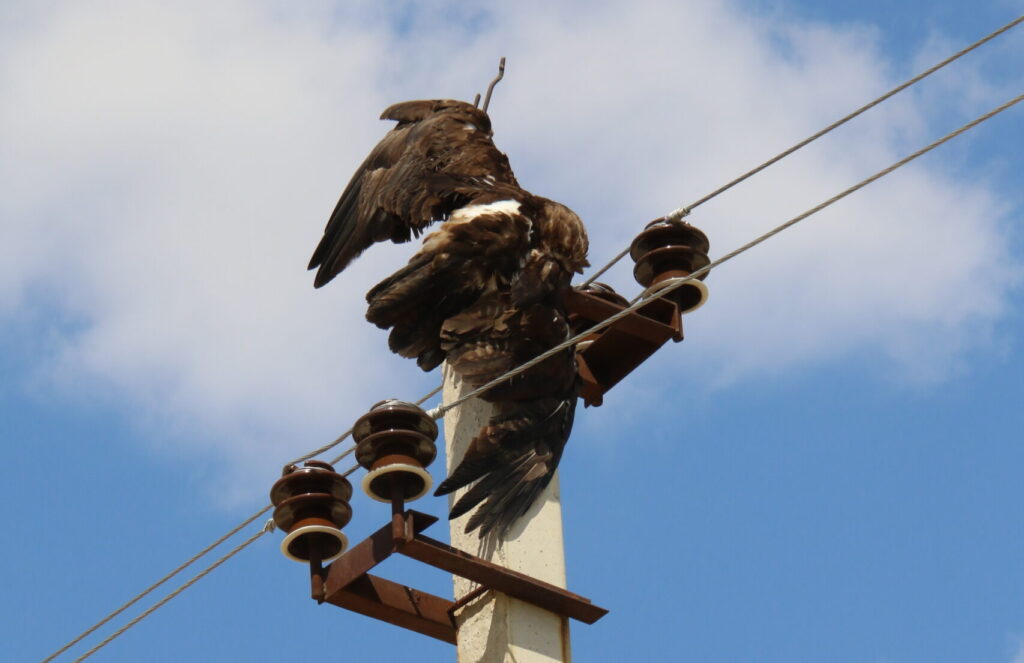459 dead birds per 754 kilometers surveyed. In Western Kazakhstan, the mass death of birds on overhead power lines has once again been confirmed
In October 2024, the Kazakhstan Association for the Conservation of Biodiversity (ACBK) has completed an ornithological survey of overhead power lines (overhead lines) in West Kazakhstan and Aktobe regions. As a result of the study, the death of 459 birds was recorded, which indicates a significant negative impact on the populations of the steppe eagle and other species of birds of prey. ACBK specialists identified particularly dangerous areas and assessed the degree of risk to birds using the Survey123 program, fixing the location of the remains with photographs.
The study was conducted as part of the Steppe Eagle Conservation Project in Kazakhstan with financial support from the UK Government for International Development and assistance from the Royal Society for the Protection of Birds (RSPB). ACBK is a non—profit organization that has been engaged for a long time in the study of the problems of bird death on the river.
(source)
Problems and statistics
According to numerous studies, the most dangerous from the point of view of electric shock are overhead power lines with a voltage of 6-10 kV on reinforced concrete supports with metal traverses, pin insulators and uninsulated wires. Birds on such lines die from electric shock when simultaneously touching the current-carrying wire and the grounded part of the support. The length of the 6-10 kV overhead line in Kazakhstan is at least 80,000 km. It is on such bird-hazardous lines that tens of thousands of birds die every year, including those listed in the Red Book of Kazakhstan. For example, in the framework of the latest ACBC study, 329 km of overhead lines were surveyed in the West Kazakhstan region, of which 248 km turned out to be dangerous, and 425 km in Aktobe, of which 218 km pose a threat to birds. In some areas, the mortality rate reached 44 individuals per 10 km. At the same time, accounting was complicated by factors such as the eating of bird remains by terrestrial predators, as well as spring floods in these areas, which means that the real mortality figures may be even higher.
Solutions
In order to solve this problem, environmental organizations recommend installing bird protection devices (BPD) on overhead line elements. The use of insulating type BPD helps to significantly reduce the likelihood of electric shock to birds landing on overhead line elements.
At the same time, in many cases, the most effective solution from the point of view of bird protection can be the underground laying of lines. The use of self-supporting insulated wires (SIW) also significantly reduces the risk of electric shock.
Equally effective solutions for newly designed and erected overhead lines with a capacity of 6-10 kV could be the use of such structures (supports, traverse and insulators) which would provide a distance of at least 1 m between the current-carrying and conductive parts of the overhead line. Such structures themselves could be considered electrically safe for birds. And their use together with the BPD brings the probability of electric shock to the bird to zero.
At the moment, environmental organizations in Kazakhstan insist on a number of legislative amendments aimed at a complete ban on the design and construction of such overhead line structures that lead to mass bird deaths, as well as the operation of appropriate electro-avian overhead lines without installing a BPD. To achieve this goal, active explanatory and normative work is being carried out in cooperation with state authorized bodies and environmental organizations, as well as work on standardization of the use of BPDs.
At the moment, the first version of the draft "BPD Standard for overhead power lines" is ready, which is aimed at discussion by key stakeholders. The implementation of this standard will allow the owners and designers of overhead lines to apply clear technical requirements to ensure the safety of birds.

